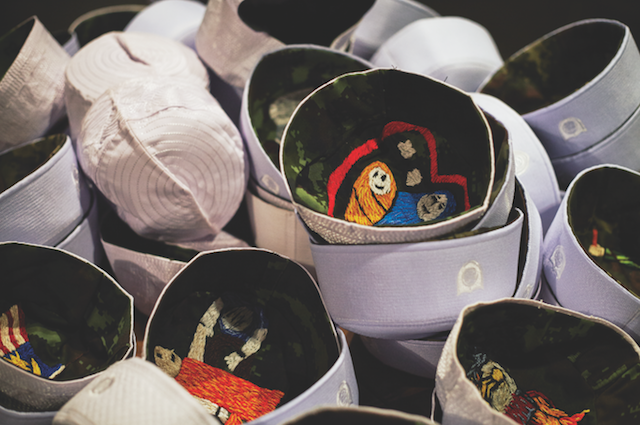Bangkok Art & Culture Centre 1 April – 13 May
Uniting two new installations with an acclaimed old one, Thai textile artist Jakkai Siributr’s latest exhibition begins with an open, if unspoken, invitation to dress up. Three clothing racks lined with military camo jackets and a table piled with white Muslim-Malay skullcaps, or songkoks, greet the viewer. You approach Changing Room (2017) gingerly and find something amiss: while the jackets are mostly embroidered with happy, faux-naïf scenes of life in Thailand’s Muslim insurgency-stricken deep south, the linings of the skullcaps crudely depict the region’s all-too-quotidian horrors. There are embroideries of armed separatists holding up Malaysian flags, of shot-up cars and of bloodied soldiers, among other violent images. Yet most visitors appear OK with all this carnage – they duly slip into character and proceed to check themselves out in the full-length mirror provided, take selfies or pose for photographs. Contrasting the blindly sanguine hopes of a stalled, military-led peace process with the jittery day-to-day existence of civilians there, this high-stakes work walks a fine line between pricking our conscience and infantalising us.
Moving on, the tonal dissonance between the three works is as striking as the sociopolitical commentaries woven into each one. Brash and intuitively relatable, Changing Room uses public roleplay to address, caustically and rather cynically, the Thai Buddhist majority’s disconnect with the internecine religious and ethnic conflicts in the country’s southern border provinces. By contrast, the installation next to it, 78 (2014), is cut from more dignified cloth. First shown at Art Basel Hong Kong in 2014, it’s a disquietingly stoic tribute to the victims of one of the most diabolical examples of state-sanctioned heavy-handedness in living memory: the Tak Bai incident of October 2004. The outside of this mysterious, 3.5m-high black fabric cube, which is modelled loosely on the Kaaba, the sacred cube at the heart of Mecca, is embellished with brass-coiled embroidery and stylised Thai script. Inside, the sepulchral feeling heightens. Disturb its meditative air of funereal sanctity by peeling back the curtain and entering its metal scaffold frame and you find 78 white kurta tunics laid out neatly on tightly stacked bamboo bunks – one for each of the male Muslim protesters who died from suffocation after being arrested in the southern Thai province of Narathiwat, bound and stacked onto trucks by the military. Unsurprisingly, people talk in whispers in here, if at all.
Using hand stitching, appliqué and other domestic craft techniques, Jakkai has to date keenly and ironically unpicked parochial themes pertaining to his homeland
Curated by Iola Lenzi, the show’s triumvirate of tactile work is completed by The Outlaw’s Flag (2017), a display of 21 imagined flags coarsely embroidered with seeds and beads. These were gathered by Jakkai during a 2015 research trip to Sittwe, the city in Myanmar’s Rakhine state from which many Rohingya, an ethnic Muslim minority, have fled persecution at the hands of the country’s Buddhist majority, escaping on boats only to find that their travails – statelessness, poverty, exploitation – have only just begun. Made by Jakkai and his three helpers, the flags hang askew on wood rails and blend emblems and symbols lifted from the flags of Bangladesh, Myanmar, Malaysia and Thailand – the four countries embroiled in this ongoing refugee crisis. Meanwhile, sombre documentary footage of the main points on the Rohingya’s journey, including Sittwe, plays on two video screens beside them.
Using hand stitching, appliqué and other domestic craft techniques, Jakkai has to date keenly and ironically unpicked parochial themes pertaining to his homeland, including its entrenched customs and the crass commercialisation of Theravada Buddhism, one of the three pillars of Thai society. But Displaced, which is the result of months of ethnographic research, is the first solo show to find him, a practising Buddhist, exploring the fate of people who sit just outside the field of experience of most metropolitan Thais, including its ruling military junta and Jakkai himself.
Given the global surge of ethnocentrism, all I can say is that it feels right for now. Veering jarringly and provocatively between moments of pathos, empathy and unsettling Instagram-friendly entertainment, this is, despite the Buddhist–Muslim lens, a taut and timely show about a universal theme: the other and how we perceive them. In this way, the Displaced of the title refers not just to those uprooted by the social and political frictions of our age, but also the feelings of more privileged viewers as we set about questioning our engagement – or lack of – with the wider issues raised.
First published in the Summer 2017 issue of ArtReview Asia
